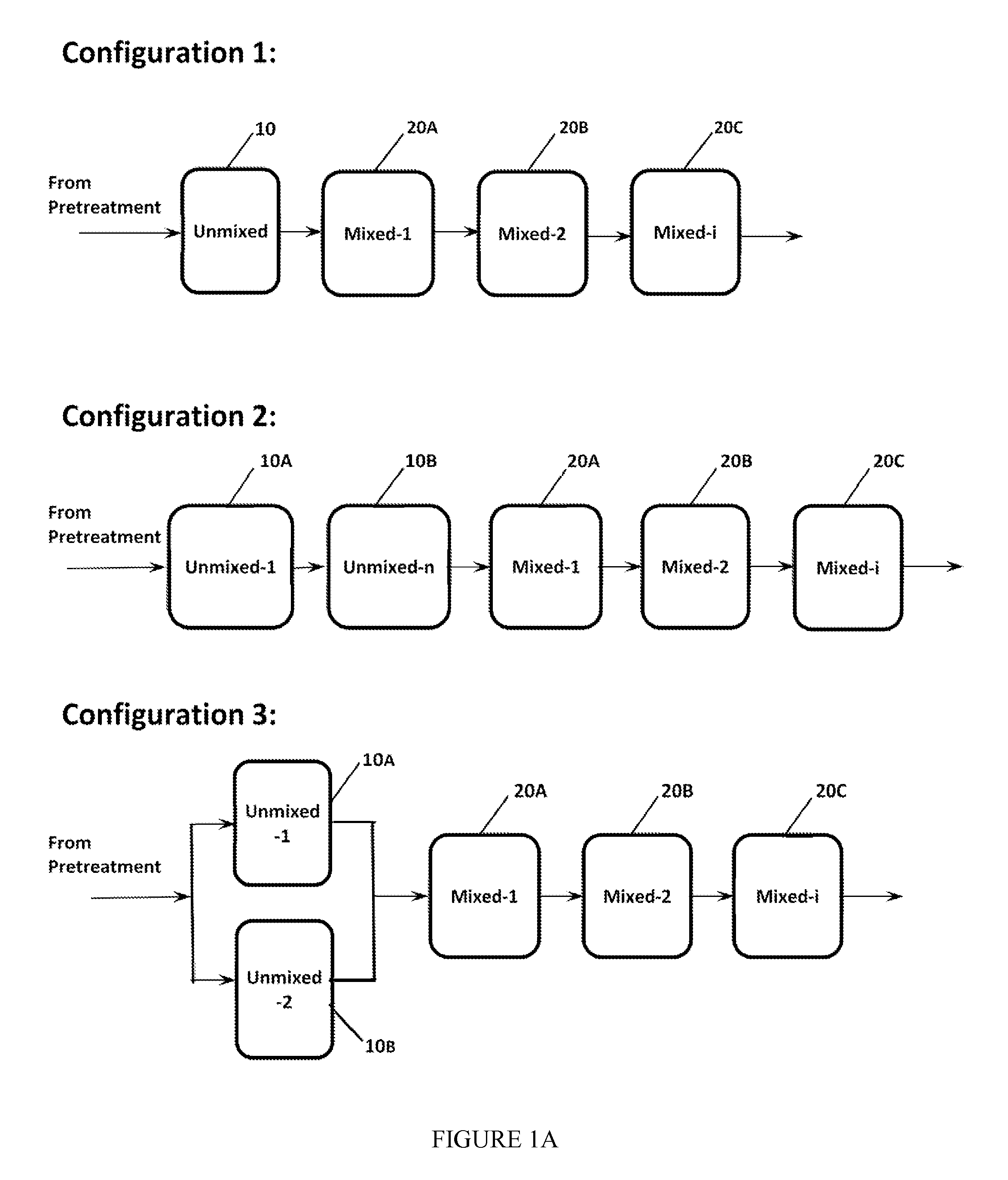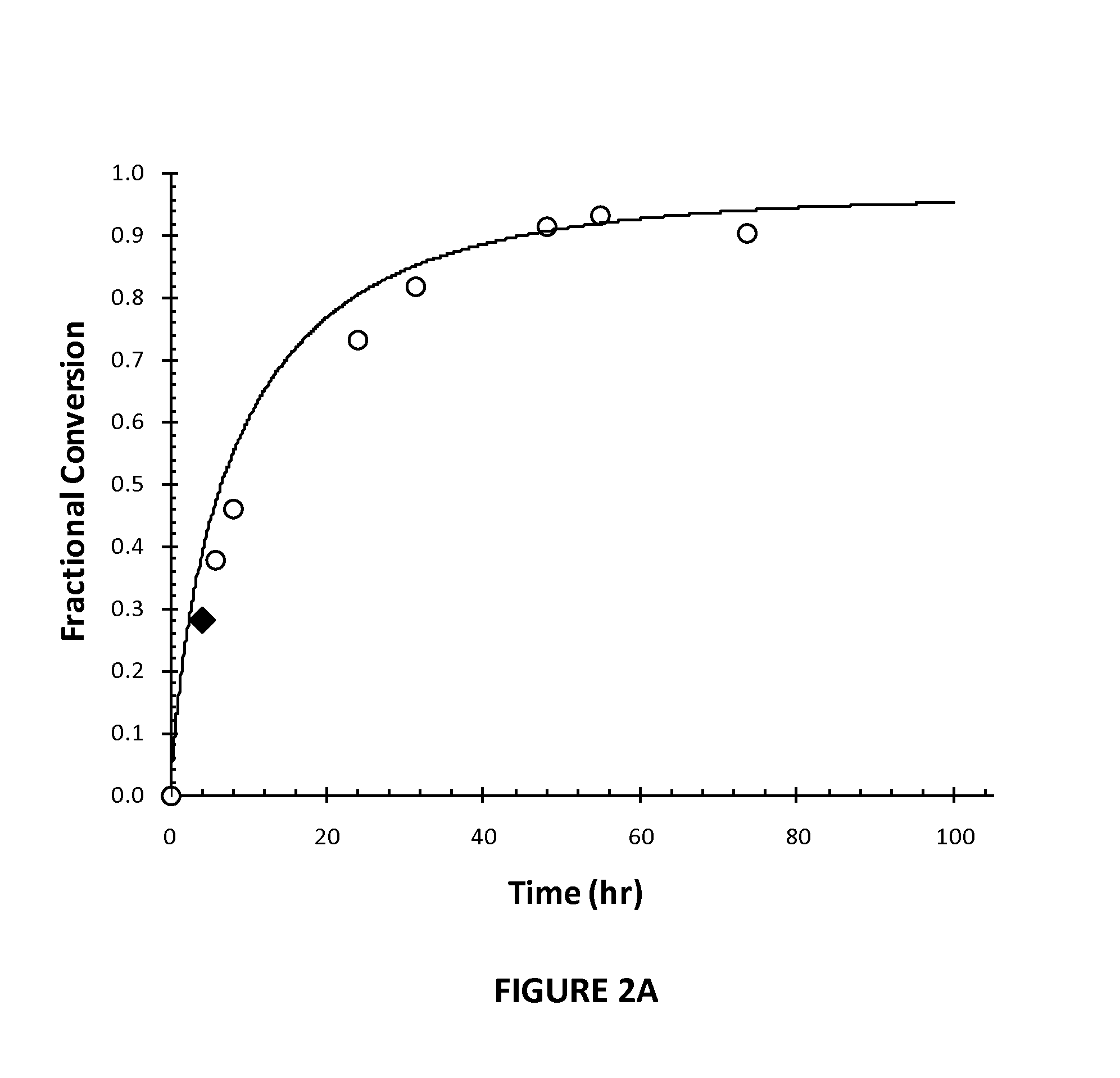Process for improving the hydrolysis of cellulose in high consistency systems using one or more unmixed and mixed hydrolysis reactors
a technology of hydrolysis reactor and cellulose, which is applied in the direction of bioreactor/fermenter, specific use bioreactor, etc., can solve the problems of increasing equipment size, increasing capital cost, and high water content in the incoming slurry, so as to reduce the viscosity of the pretreated cellulosic feedstock, reduce the power input associated with mixing in the downstream mixed reactor, and reduce the effect of high solids conten
- Summary
- Abstract
- Description
- Claims
- Application Information
AI Technical Summary
Benefits of technology
Problems solved by technology
Method used
Image
Examples
example 1
Determination of the Undissolved Solids Concentration in a Cellulosic Feedstock Slurry
[0132]The determination of the undissolved solids (UDS) content is carried out as follows.
[0133]A fixed amount of slurry is dispensed into a plastic weigh dish and the slurry weight is recorded accurately using an analytical scale. A filter paper circle, appropriately sized for a Buchner funnel, is placed in an aluminum weighing tin and the combined weight of the tin and filter paper is recorded. After transferring the pre-weighed filter paper to the Buchner funnel, the pre-weighed slurry is passed through the filter paper to isolate the solids. Small volumes of de-ionized water are used to ensure that the solids are quantitatively transferred from the weigh dish to the Buchner funnel. The solids are then washed using excess deionized water, after which the washed sample and filter paper are transferred into the pre-weighed aluminum tin. Care should be taken to ensure the solids are quantitatively ...
example 2
Determination of the Degree of Conversion of Cellulose after Unmixed or Mixed Hydrolysis
[0134]The degree of cellulose conversion is determined by measuring the initial cellulose, glucose and cellobiose concentrations and the concentrations of glucose and cellobiose after unmixed or mixed hydrolysis has taken place, and applying the following equations.
[0135]X=[(G-Go)+1.053(G2-G2o)Gmax]100Gmax=1.11Co[1.02+0.041(Co+Xo1000)]1-Co[0136]X=Cellulose conversion (%)[0137]G=Glucose concentration (g / L)[0138]Go=Initial glucose concentration (g / L)[0139]G2=Dimer concentration (g / L); includes primarily cellobiose, but also gentiobiose and other dimers[0140]G2o=Initial dimer concentration (g / L); includes primarily cellobiose, but also gentiobiose and other dimers[0141]Gmax=Glucose concentration at 100% cellulose conversion (g / L)[0142]Co=Initial cellulose concentration (%)[0143]Xo=Xylose concentration (g / L)
example 3
Determination of the Maximum Water Holding Capacity of a Pretreated Cellulosic Feedstock
[0144]The cellulosic feedstock is pretreated with acid, for example as set forth in U.S. Pat. No. 7,754,457 (incorporated herein by reference). A sample of the pretreated cellulosic feedstock of known dry weight is placed in a container without applying pressure. Water is added gradually to the sample until the point at which additional water added is free water. This point is estimated as the point wherein water forms a thin continuous layer over the cellulosic feedstock. The container is tipped to remove free water. The wet feedstock is then weighed to determine the total amount of water present, including water added and water initially present in the sample. The maximum water holding capacity per mass of dry lignocellulosic feedstock is calculated by dividing the mass of water present in the sample by the dry mass of the feedstock.
[0145]The determination of water holding capacity and the perc...
PUM
| Property | Measurement | Unit |
|---|---|---|
| wt % | aaaaa | aaaaa |
| wt % | aaaaa | aaaaa |
| wt % | aaaaa | aaaaa |
Abstract
Description
Claims
Application Information
 Login to View More
Login to View More - R&D
- Intellectual Property
- Life Sciences
- Materials
- Tech Scout
- Unparalleled Data Quality
- Higher Quality Content
- 60% Fewer Hallucinations
Browse by: Latest US Patents, China's latest patents, Technical Efficacy Thesaurus, Application Domain, Technology Topic, Popular Technical Reports.
© 2025 PatSnap. All rights reserved.Legal|Privacy policy|Modern Slavery Act Transparency Statement|Sitemap|About US| Contact US: help@patsnap.com



